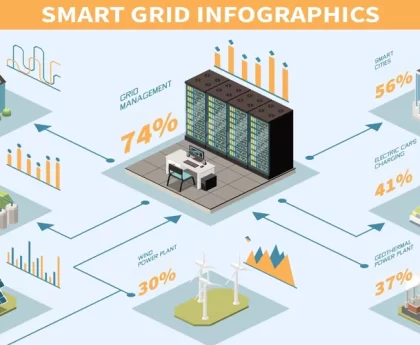Blockchain Technology is a decentralized and distributed digital ledger system that records and stores transactions across multiple computers in a secure, transparent, and tamper-resistant manner. Each transaction is grouped into blocks, which are then linked together in chronological order, creating a chain of blocks. This technology’s key features include decentralization, transparency, security through cryptography, immutability of recorded data, consensus mechanisms for transaction validation, and the potential for executing self-executing smart contracts.
Types of Blockchain Technology
Blockchain technology can be categorized into several types based on various characteristics, primarily the level of access control and decentralization.
Here are the three main types of blockchain technology:
- Public Blockchains: Public blockchains are open and permissionless networks that allow anyone to participate as a node, verify transactions, and contribute to the consensus process. They are fully decentralized and typically associated with cryptocurrencies like Bitcoin and Ethereum. Public blockchains offer high transparency and security but can be slower due to the extensive consensus mechanisms required.
- Private Blockchains: Private blockchains, also known as permissioned blockchains, restrict access to the network. Only authorized participants are allowed to become nodes and validate transactions. These blockchains are often used by enterprises, consortiums, and organizations that require control over who can join the network. Private blockchains offer faster transaction speeds and are suitable for applications where privacy and control are essential.
- Consortium Blockchains: Consortium blockchains are a hybrid between public and private blockchains. They are designed for use by a specific group of participants who jointly manage the blockchain. While they offer more decentralization compared to fully private blockchains, consortium blockchains still maintain a level of control over membership and validation. This type is often utilized in industries where collaboration among multiple entities is crucial.
Additionally, blockchain technology can also be classified based on consensus mechanisms:
- Proof of Work (PoW): PoW is the original consensus mechanism used in Bitcoin. Participants (miners) solve complex mathematical puzzles to validate transactions and create new blocks. This requires significant computational power and energy consumption.
- Proof of Stake (PoS): In PoS, participants (validators) are chosen to create new blocks and verify transactions based on the number of tokens they hold and are willing to “stake” as collateral. This mechanism is more energy-efficient compared to PoW.
- Delegated Proof of Stake (DPoS): DPoS is a variation of PoS where token holders vote to select a limited number of delegates who are responsible for validating transactions and maintaining the blockchain. This enhances scalability and speed.
- Proof of Authority (PoA): In PoA, validators are identified entities, often individuals or organizations with a reputation to uphold. Validators are selected based on their authority, reducing the need for resource-intensive computations.
- Proof of Space, Proof of Time, and more: There are other consensus mechanisms being explored, such as Proof of Space, where participants prove they have allocated a certain amount of disk space, and Proof of Time, where the age of a cryptocurrency holding influences the likelihood of being chosen as a validator.
The choice of blockchain type and consensus mechanism depends on the specific use case, requirements, and goals of the application being developed.
Benefits of Blockchain Technology
Blockchain technology offers a range of benefits across various industries and applications due to its unique characteristics.
Here are some key benefits of blockchain technology:
- Decentralization and Trust: Blockchain operates on a decentralized network, eliminating the need for a central authority or intermediary to verify transactions. This enhances trust between participants as transactions are verified by consensus among multiple nodes.
- Transparency and Immutability: Once a transaction is recorded on the blockchain, it becomes nearly impossible to alter or delete. This immutability ensures that the transaction history is transparent and auditable, reducing fraud and unauthorized modifications.
- Security: Transactions on the blockchain are secured using cryptography. The distributed nature of the ledger makes it highly resistant to hacking and tampering. The need for consensus among multiple participants before transactions are added further enhances security.
- Reduced Intermediaries: Blockchain technology eliminates the need for intermediaries in transactions, which can result in faster and more cost-effective processes. This is particularly beneficial in industries like finance and supply chain management.
- Efficiency and Cost Savings: Automation of processes through smart contracts, which execute automatically when predefined conditions are met, can lead to significant efficiency improvements and cost savings.
- Global Accessibility: Public blockchains are accessible to anyone with an internet connection, enabling global participation without geographical restrictions. This is especially useful for cross-border transactions and remittances.
- Traceability and Accountability: In supply chains, blockchain can provide real-time tracking and visibility of goods and products, allowing stakeholders to trace the origin and journey of items, thus enhancing accountability.
- Data Integrity: Blockchain’s decentralized nature prevents a single point of failure, reducing the risk of data loss. Additionally, data stored on the blockchain is timestamped and linked to previous transactions, adding a layer of data integrity.
- Disintermediation: Blockchain can disrupt industries that heavily rely on intermediaries, such as financial institutions and legal services, by enabling peer-to-peer interactions and reducing the need for intermediaries.
- Micropayments and Tokenization: Blockchain facilitates microtransactions and tokenization of assets, enabling new monetization models and enhancing the transfer of value for digital goods and services.
- Privacy and Control: While public blockchains are transparent, private and consortium blockchains offer enhanced privacy through selective access and permissioned participation, making them suitable for sensitive business processes.
- Innovation: Blockchain’s unique features have led to the development of new business models, applications, and ecosystems, fostering innovation across industries like finance, healthcare, supply chain, and more.
It’s important to note that while blockchain technology has these benefits, it also comes with challenges and considerations, including scalability, energy consumption (for certain consensus mechanisms), regulatory concerns, and the need for appropriate use cases to maximize its advantages.

How Does it Work
Blockchain technology works through a combination of decentralized network architecture, cryptographic principles, consensus mechanisms, and data structure.
Here’s a simplified overview of how it works:
- Decentralized Network: A blockchain operates on a decentralized network of computers, often referred to as nodes. Each node has a copy of the entire blockchain ledger, which contains a record of all transactions that have ever occurred on the network.
- Transactions: Transactions are initiated by participants within the network. These transactions can represent the transfer of digital assets (like cryptocurrencies), contracts, ownership records, or any other form of digital information.
- Blocks: Transactions are grouped together into blocks. Each block contains a list of transactions, a timestamp, and a reference to the previous block, forming a chain of blocks. This linkage ensures the chronological order and integrity of the ledger.
- Consensus Mechanism: Before a block is added to the blockchain, the network must agree that the transactions within it are valid. This agreement is reached through a consensus mechanism, which is a set of rules that dictate how nodes verify transactions and come to a consensus. Common consensus mechanisms include Proof of Work (PoW), Proof of Stake (PoS), and more.
- Mining (Proof of Work): In PoW-based blockchains (like Bitcoin), miners compete to solve complex mathematical puzzles. The first miner to solve the puzzle gets the right to add the next block to the blockchain and is rewarded with new cryptocurrency units and transaction fees.
- Validation (Proof of Stake and Others): In PoS-based blockchains (like Ethereum 2.0), validators are chosen to create and validate new blocks based on the amount of cryptocurrency they hold and are willing to “stake” as collateral. Other consensus mechanisms have their own ways of selecting validators or participants.
- Cryptographic Hashing: Each block contains a unique code called a cryptographic hash, which is a mathematical representation of the block’s contents. This hash is derived from the transactions in the block and the hash of the previous block. If any change is made to the block’s data, the hash would change, alerting the network to potential tampering.
- Immutability: Once a block is added to the blockchain, it is nearly impossible to alter the data within it. Changing the data in one block would require changing the data in all subsequent blocks, which becomes exponentially difficult due to the cryptographic links between blocks.
- Consensus and Trust: The decentralized nature of the network and the consensus mechanisms ensure that transactions are validated and recorded in a trustworthy manner without the need for a central authority. Trust is established through cryptographic techniques and the agreement of multiple network participants.
- Smart Contracts: In addition to transactions, blockchain networks can execute self-executing smart contracts. These are programmable scripts that automatically trigger actions when predefined conditions are met. They enable complex automation and execution of agreements without intermediaries.
Overall, blockchain’s combination of decentralization, cryptography, consensus mechanisms, and data structure creates a secure and transparent way to record and verify digital transactions, offering various benefits for a wide range of applications.
Who Created Blockchain?
Blockchain technology was introduced by an individual or group using the pseudonym “Satoshi Nakamoto.” In 2008, Nakamoto published a whitepaper titled “Bitcoin: A Peer-to-Peer Electronic Cash System,” which outlined the concept of a decentralized digital currency and the underlying blockchain technology. The whitepaper proposed a solution to the double-spending problem in digital currencies by using a proof-of-work consensus mechanism and a chain of blocks to record transactions.
Satoshi Nakamoto’s identity remains unknown, and the name is widely believed to be a pseudonym used by the creator or creators of Bitcoin and the blockchain technology. Despite the mystery surrounding the identity, Nakamoto’s contributions laid the foundation for the development of blockchain technology and the emergence of cryptocurrencies.
It’s worth noting that while Nakamoto introduced the concept of blockchain and Bitcoin, the technology has since evolved, and many different blockchain implementations and projects have emerged, each with their own features, consensus mechanisms, and applications.
How to Store Data in Blockchain?
Storing data on a blockchain involves encoding the data into transactions and adding those transactions to the blockchain’s ledger. However, it’s important to note that not all blockchains are designed to store large amounts of data, as their primary purpose is to maintain a ledger of transactions. Some blockchains, like Bitcoin, have limitations on the amount of data that can be included in each transaction.
Here are the general steps to store data on a blockchain:
- Encoding Data: Convert the data you want to store into a format that can be included in a transaction. This could involve converting text, files, or other data into a suitable format, such as hexadecimal.
- Transaction Creation: Create a transaction that includes the encoded data. Transactions typically have inputs (sources of funds) and outputs (where the funds are sent). In this case, the output might be a special script or address that signifies data storage.
- Transaction Signing: If the blockchain requires transactions to be signed by the sender’s private key, sign the transaction using the appropriate private key associated with the sender’s address.
- Transaction Broadcasting: Broadcast the transaction to the blockchain network. Other nodes in the network will receive and validate the transaction.
- Miner/Validator Confirmation: Depending on the blockchain’s consensus mechanism, miners (Proof of Work) or validators (Proof of Stake) will confirm the transaction and add it to the next block.
- Transaction Inclusion in Block: Once the transaction is included in a block, it becomes a permanent part of the blockchain’s history. The block’s hash and the previous block’s hash link the data to the rest of the blockchain.
It’s important to consider a few points when storing data on a blockchain:
- Cost: Storing data on a blockchain can incur costs, as transactions may require fees. These fees can vary depending on the blockchain network’s congestion and the amount of data you’re storing.
- Size Limitations: Some blockchains have limitations on transaction size, meaning you might not be able to store large amounts of data in a single transaction.
- Privacy: Public blockchains offer transparency, which means the stored data will be visible to all participants. If privacy is a concern, you might consider using private or consortium blockchains.
- Use Case: Make sure the use case warrants using a blockchain for data storage. Storing large amounts of data might be more efficient using traditional databases, while blockchains are better suited for cases where immutability, transparency, and decentralized control are crucial.
- Decentralization: Consider whether you want to store the data on a public blockchain (accessible to anyone) or a private/consortium blockchain (accessible to selected participants).
- Smart Contracts: Some blockchains support more advanced data storage and retrieval through smart contracts. These contracts can automate interactions and logic related to the stored data.
Keep in mind that as blockchain technology evolves, new methods and solutions for data storage within blockchains might emerge. Always consider the specifics of the blockchain platform you’re using and the intended use case for your data storage needs.
Cloud Computing: Definition, Types, Scope, & Benefits





